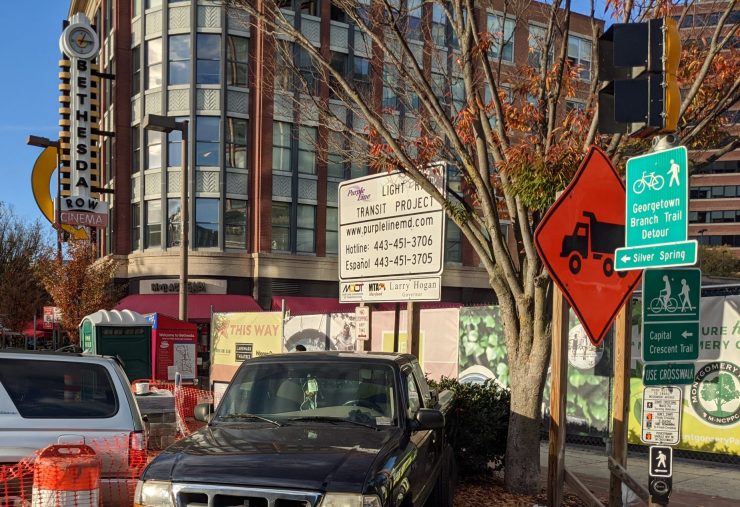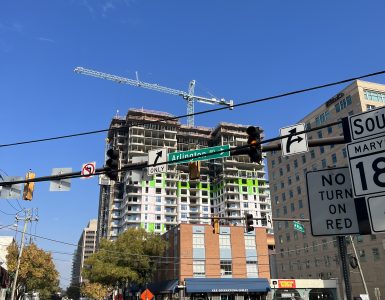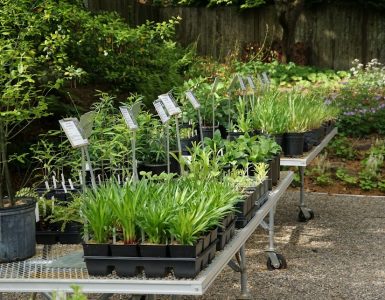Bikes and pedestrians along the Capital Crescent Trail meet more and more construction, forcing them to funnel onto shared narrow walkways and contend with busy intersections.
Carol Reeves, a Bethesda resident, said a main concern of the construction is the danger of bicyclists having to be on sidewalks. “They just go too fast for it to be safe. And it’s scary. But, I can’t blame them, I mean, the sign says they should be here, but it just feels dangerous,” she said.

The cycling community echoes her concern. Narrow sidewalks force bikes and walkers to yield to one another while trying not to drop down into the active roadway beside them. Throughout Bethesda, the roadways have a number of bike lanes, but the construction across downtown has significantly disrupted many of those. The construction doesn’t seem to have an end in sight.
The Purple Line is a light rail project that Maryland hoped would connect Bethesda in Montgomery County to the town of New Carrollton in Prince George’s County. Much of the project is supposed to connect to main transportation options, with local buses, Amtrak and Metro Transit Authority supporting it. In the spring of 2016, the state chose a private-sector partner, Purple Line Transit Partners, to design and build, then operate and maintain the light rail system over the next 35 years. Just this year, PLTP left the project due to delay costs and other issues.
The reality in Bethesda is construction along the Purple Line route causes some significant pedestrian issues. Other construction projects also contribute, but the recent upheaval along the Purple Line corridor gives many Maryland residents cause for concern.
Jeff Lemieux is worried about how these frustrating delays will play out. He’s the husband of Laurie Lemieux, who owns Proteus Bicycles in College Park, Maryland. “We’re huge Purple Line supporters, but we’re concerned that there’s gonna be delays,” he said. “It’s really an exciting public transport project, but I just hope that it gets done right.” Construction delays aren’t just a small concern either, “If there’s a construction impediment for ten years, like, that would be a big problem!”

The current plan for the Purple Line does include a number of pedestrian access options, but most of those options have little to do with current conditions. Riding along Capital Crescent Trail, it abruptly changes from a casual and comfortable trail for cyclists and pedestrians to busy downtown Bethesda, placed out on a roadway that’s currently under construction.
Weaving through open-air restaurants that have taken advantage of the closed road, you soon come to a residential street dissected by stop signs. That relatively calm street then gives way to some of Bethesda’s largest and busiest roadways, with directions for bicycles to use sidewalks to connect to the neighboring trail. The maneuver is interspersed with detours, closed roads, busy intersections, and redirecting one-way streets.

A pedestrian tunnel to connect Capital Crescent Trail below Bethesda’s main heart would alleviate many of those problems. However, that tunnel isn’t scheduled to open until 2026 and delays continue to plague the project.
Every day that work isn’t being done on a contract, a litany of factors lose money. The initial cost estimates for the Purple line were near $2.4 billion. Using that number as a baseline, a conservative estimate for each day of delay since 2016 would cost $1 million. That cost isn’t just shouldered by Marylanders, as Metro Transit Authority asked the federal government for $900 million in funding. However, current project estimates sit at $5.6 billion.
Delays are coming from all different sources. The global pandemic caused delays, as did basic construction changes and concerns. The surprise delay was a lawsuit filed by Friends of Capital Crescent Trail. The organization’s main suit against the state caused a reported 266 days worth of delays and nearly $200 million in delay costs. This appears to be the final number for a year’s long legal campaign by Friends of Capital Crescent Trail. Those delay costs resulted in a federal judge ruling that there was nothing wrong with construction permits.
Prince George’s County Council Member Dannielle Glaros has been one of the more outspoken public officials on the project. Nine of the 11 stations for the Purple Line are in her district. Friends of Capital Crescent Trail were trying to “stall and kill the project,” she said in a statement recently.
The future of both the pedestrian trails and walkways and the Purple Line project itself is still up in the air. Council Member Glaros described it as “… more like a rollercoaster ride than the planned 16-mile light rail connecting Montgomery and Prince George’s counties. Almost as if the communities I represent and I are stuck upside down at the top of a loop.”
The Wash contacted the Deputy Project Director for the Purple Line, both by phone and by email. We wanted to know what the current delay costs were across the project, where different costs may have come from, and the status of vehicle and pedestrian traffic detours since the state had taken over the project. We have not received any information.















Add comment